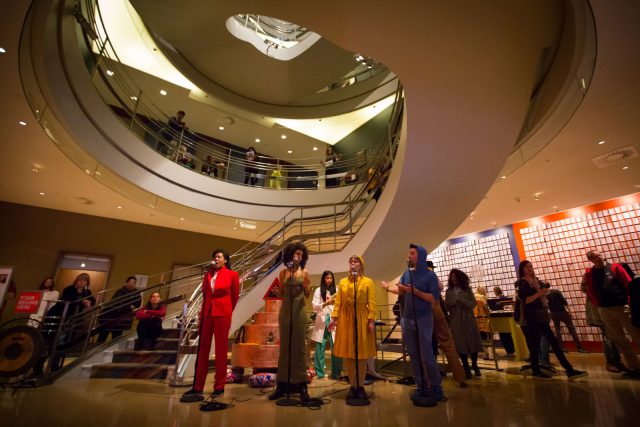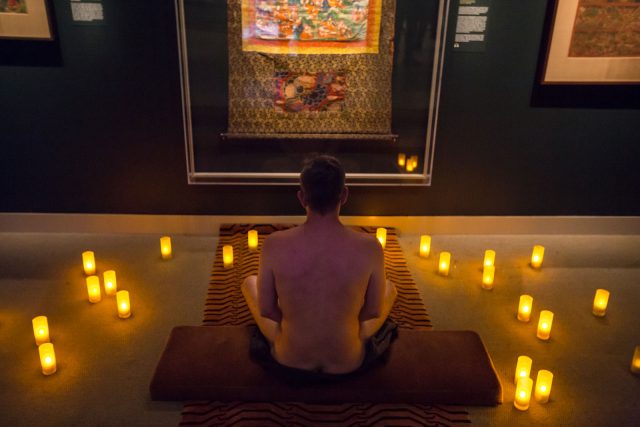Restlessness is a common ailment among New Yorkers. This was certainly the case during the 1960s and ’70s, when the concrete jungle was abuzz with avant-garde artists challenging the ways we construct meaning. Among them were a generation of American Zen Buddhist artists, including Yoko Ono, Joseph Beuys, Nam June Paik, and John Cage, who emerged as forerunners of the Fluxus art movement. Their aims were overtly Buddhist: to loosen wrongheaded habits rooted in delusion and transform them into enlightened qualities.
FluxBuddha, a performance art event conceived by New School religious studies professor and self-professed “consciousness hacker” Christopher Kelley, is both an homage to these countercultural icons and a creative play on traditional Tibetan Buddhist rituals. The interdisciplinary art concert will premiere at the Rubin Museum on Saturday, April 21.
In a museum takeover, FluxBuddha performers—an eccentric cast of artists, scholars, yogis, Buddhist practitioners, Tibetologists, and neuroscientists—will occupy all six floors of the exhibition areas. The hallways will be flooded with bodies in motion, and attendees will have to wander amid dancing gandharvas [celestial musicians and messengers] and roller-skating dakinis [female wisdom deities], pass by a human prayer wheel, and take an “I” exam, in which participants read a passage from the Heart Sutra off an eye chart. Each interactive demonstration will explore foundational Buddhist concepts such as impermanence, attachment, nonself, and emptiness.
Kelley’s intention, as he shares below, is to disrupt reified beliefs we have about ourselves and the world around us.
How is the Fluxus art movement and its ideology connected to the history of American Buddhism? In the 1960s, the prevailing question was how do we enact and practice Zen as modern people living in New York City? At the time, D. T. Suzuki, an eminent Japanese Zen teacher, translator, and author, was all the rage. Beatniks were reading him. Intellectuals like John Cage were reading him. Suzuki was one of the great interlocutors who helped the first generation of Zen Buddhist Americans make sense of Buddhist teachings and bridge the cultural divide. And Cage, whose experimental music classroom was an incubator for new and different ideas, was very much the conduit between Zen Buddhism and Fluxus.
Zen has its own aesthetic and energy, which is distinct from other forms of Buddhism, but it fits very well with the sensibilities of the avant-garde; both pedagogies have a lot to do with shock and disruption. In their own way, each modality aims to knock you out of illusion and into a more awakened state of consciousness. In Zen Buddhism, koan practice or a nice slap over the head could be the electric kick you need to snap out of the daydream.
“One for Violin” is a quintessential Fluxus performance that involves someone picking up a violin, raising it overhead, and smashing it to pieces. In an instant, you move from “violin” to no violin, and you’re able to rest in that sliver of emptiness. The performance, more than anything, exposes the process by which we develop attachments and cling to objects as being more than the sum of their parts. This momentary experience of nonduality would resonate with any Buddhist.
One of the most radical Buddhist exercises is to question the way in which we build a solidified sense of self. What’s so troublesome about reification? One major misconception that people have when they first study Buddhism, philosophers like Nietzsche included, is that they read into the concept of nonself as quite literally meaning the absence of a metaphysical self. The historical Buddha, however, did not preach nihilism.
Tibetan Buddhism and Madhyamaka [the Middle Way School] philosophy in particular teach us that the self is an emergent phenomenon. You’ve got a bunch of parts called the five skandhas [aggregates or components of human existence] that come together, and out of that collection emerges an entity that we call the self. But when you try to find that “self,” you can’t pinpoint it. It only exists in the mind. There’s nothing inherently wrong with that.
The real problem is not the self, but our grasping on to it, believing it to be something that is absolute and needs defending. Shantideva, an 8th-century Indian Buddhist poet, monk, and scholar, guards against the self-cherishing mind, which sits at the root of all conflict. The difficulty lies in figuring out how to get over the ego. Now, this doesn’t mean ignoring your own well-being or negating the self, but rather gaining some distance from its stronghold and inhabiting a space that is less reactive.
How will FluxBuddha try to express these ideas through performance? One of my earliest memories of my aunt, a Tibetan Buddhist nun, was watching her build a personal mandala using concentric rings as part of her morning ritual. We shared an adjoining bathroom, and I remember spying into her room while she made these offerings. As she meditated and recited prayers, she slowly filled a plate with semi-precious jewels to form a symbolic Mount Meru, which she then offered to the buddhas.
To me, this is a form of performance art. As an American Fluxus adaptation of this ritual, we’ll be creating a communal 21st-century mandala made entirely of phones. As people walk through the Rubin’s doors, they will experience an immediate sense of surrender by being required to check their phones. They’ll have to separate from this very precious thing, which elicits so much of our modern sense of self, and offer its ascribed value to a complete stranger. It’s an opportunity to practice nonattachment and generosity.
In what ways can we open ourselves up to other styles of knowing that aren’t necessarily thought-based or cognitive? Everybody tends to view the Enlightenment as this historical moment when the mind and body were torn asunder. Today, we continue to place primacy on intellectual and cerebral knowledge. Performance art, on the other hand, is action-oriented and embodied. It has everything to do with the concept of body knowledge, or returning to the body as a profound source of spiritual insight. It’s about being there in the flesh, and in the case of FluxBuddha, combining physicality and action.
Before I went to graduate school and became an academic, I was a 220-pound football player. Come to think of it, I was not a particularly good student. During practice, our coach would shout out certain plays—it’s all numbers—and I would fumble time and time again. Finally, he came over to me, hit me on the head and said, “Stop thinking, and just do it.” That was my coach’s trademark pedagogy. Without much of a choice, I “turned off” my head and let my body drive. Only then did I realize I had run the right play. In Chinese philosophy, they describe this experience as wu wei, or thinking without thinking. There’s wisdom in the body, and you screw it up when you try to bring in reason and logic.
Why should we think twice before shrugging off religious ritual, and what does it have to do with art and embodied experience? Buddhism, as I understand it, is living performance art, and ritual practices can open doors to mystical or religious dimensions of experience. Ritual is action-based, and what all these practices have in common is the body. Part of our Western hang-up with ritual is that we aren’t comfortable in our bodies.
Related: Revisiting Ritual
People can engage with ritual more comfortably inside a museum, a socially accepted space where anything can happen. There is less resistance because regular rules don’t apply. If we’re going to return to ritual, I don’t think it’s going to happen in churches or temples. It’s going to happen in places like art galleries, where we actually feel free to experiment.
FluxBuddha is part of the Rubin Museum of Art’s Brainwave Festival.
Update: This event took place on April 21, 2018. Below are some scenes from the performance.





Thank you for subscribing to Tricycle! As a nonprofit, we depend on readers like you to keep Buddhist teachings and practices widely available.
